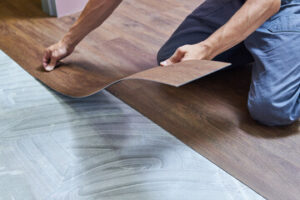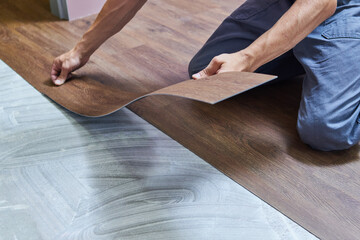Whether you are looking for the look of hardwood or stone flooring but want to avoid paying the high price tag, vinyl is a great option. It can achieve the look and feel of these materials with flawless images, realistic textures, and individual planks or tiles. Vinyl is easy to install, especially if you hire a professional. However, you should acclimate the product to your home for at least 48 hours before installation begins.
 Vinyl flooring is a durable and versatile option for a wide range of homes. It is often cheaper than other types of flooring and can last for years without requiring major maintenance. However, there are several factors that can affect the cost of vinyl flooring installation. The cost of vinyl flooring can be influenced by the type of material you choose and the complexity of the installation process. It is also important to consider the size of your house and any special considerations that may need to be taken into account.
Vinyl flooring is a durable and versatile option for a wide range of homes. It is often cheaper than other types of flooring and can last for years without requiring major maintenance. However, there are several factors that can affect the cost of vinyl flooring installation. The cost of vinyl flooring can be influenced by the type of material you choose and the complexity of the installation process. It is also important to consider the size of your house and any special considerations that may need to be taken into account.
If you’re planning to install a new floor in your home, it is crucial to know whether the existing subfloor will allow for the installation of your chosen floor. This will help you budget accordingly for any required repairs. Another factor that will determine the costs of your project is the layout of your house. A complicated layout can make the job more time-consuming, which will increase the overall labor costs.
Old flooring removal is also an important aspect of any home renovation, and it can also add to the cost of vinyl flooring installation. Depending on the type of flooring, removal can vary from $1 to $4 per square foot. As a result, you will need to budget accordingly for any potential costs associated with the removal of old flooring. It is a good idea to have your contractor remove the old flooring before installing the new one.
You should also prepare your subfloor before the installation of the vinyl floor. This includes filling low spots and repairing cracks. This will ensure that the flooring is level and that it will not be susceptible to uneven wear.
Once the subfloor is prepared, the installer can begin to install the flooring. There are various types of adhesives that can be used to secure the vinyl flooring to your subfloor. If you have a hardwood or tile subfloor, your installer will be able to provide advice on which adhesive will work best for your specific subfloor.
The labor cost of vinyl flooring installation can vary greatly, but it typically falls within a range of $3-$10 per square foot. This range varies by geographical location, as urban areas tend to have higher labor costs than rural ones.
If you need help fitting vinyl planks or sheets, there are a number of local Vinyl Flooring Installers who can do the job. You can find a list of these professionals by contacting your local home improvement store. They may also be able to put you in touch with an aggregator that can connect you with a professional installer near you.
Luxury vinyl planks are one of the easiest floors to install and can be installed in any season. They don’t need to acclimate to the room and can be installed over almost any type of floor, provided that it is smooth, flat, and dry.
LVP floors are also resistant to water damage, making them ideal for kitchens and bathrooms that are susceptible to spills or other liquids. In addition, they come in a wide variety of styles and colors, so you can pick the best match for your space.
When choosing a vinyl plank flooring installation company, look for a professional who can work within your budget and schedule. Some will charge per square foot, and some will offer packages.
The price of the materials will determine how much it costs to install your new floors. For example, a vinyl plank with a premium vinyl finish will cost more than a less expensive option.
You should also factor in labor and other fees associated with the project. These costs can vary depending on the size of the job, the amount of labor needed, and whether you need extra support.
There are several ways to calculate the labor costs of a vinyl floor installation project, including using a calculator or by consulting an expert. A good flooring contractor will be able to provide you with an accurate estimate, and they can answer any questions you have about the process.
Another way to determine your labor costs is to consider how many rooms are being covered and the size of the area you need to cover. The more rooms you need to cover, the more time and labor will be required.
You should also take into account the thickness of the floor and whether it will need to be cut or trimmed. A vinyl sheet is typically easier to install than individual tiles or planks, but cutting it to a precise size can be challenging.
Vinyl Flooring Installers are a great option for a homeowner looking to replace their current floor with a more durable and attractive option. They are also relatively inexpensive and easy to install, making them a good choice for DIYers.
Choosing the right type of flooring can make or break your installation project. If your new floors are not a good fit for your specific needs, they could end up falling apart over time. This is especially true if your home has a large amount of natural light or if there are a lot of pets or children in the house.
For instance, if you have dogs or children, you may want to choose vinyl floors with an anti-slip backing. This will ensure that your new floors won’t fall over or get ruined by your pets or kids.
You can also select vinyl that is textured or patterned or made to mimic other types of flooring. The design of your floor will influence the cost of the materials you’ll need and the amount of labor involved in installing it. For example, laying down vinyl in a herringbone pattern or a chevron design will increase the cost of the planks and incur additional labor costs.
Your first step is to prepare the subfloor, which will be the surface on which your new floor is installed. You should remove all old flooring and any threshold strips that trim out the doorways. You should then thoroughly clean the subfloor. This will help you identify any nails or staples that were driven below the surface of your flooring.
Then, measure the room where you’d like to put in your new floor. This will allow you to purchase enough material to cover the entire floor and any extra pieces that you might need for cutting or replacements.
Once you have all your materials in place, begin your installation by placing the first piece of vinyl on the center line of the room and connecting adjoining pieces end-to-end. This method is ideal for interlocking planks and can be done quickly.
Vinyl flooring is a great choice for most homes because of its long-lasting strength and beauty. However, just like other floors, it needs proper maintenance to keep it looking its best.
The good news is that vinyl floor care is very easy and inexpensive to do. If you follow a few simple steps, you can make sure your vinyl flooring stays in tip-top shape for years to come.
One of the most important things to do when cleaning your vinyl floors is to sweep or dust mop them daily. This will remove any ground-in dirt or debris, including grit and oil, that can cause discoloration or staining over time.
You also need to wipe up any spills as soon as possible, as they can spread to other areas of the floor if left to sit for too long. Heavy furniture can also damage a vinyl floor by dragging across it. To prevent this, put felt tips or flat nylon floor protectors on the legs of furniture.
If your home is in an area that gets heavy traffic, consider laying a rug or doormat to cut down on dings and scratches from shoes and boots. This is especially helpful in high-traffic rooms, such as the kitchen and laundry room.
Besides protecting the floor, these mats will also remind your guests or family members to wipe their shoes before entering the home. They can also catch any chemicals, such as dirt, mud, or sand, that might get tracked in.
A doormat should also be placed at each entrance to your home. This will keep corrosive substances, such as dirt, sand, oil, grit, or driveway sealer, from being tracked onto your floors and into the rest of your house.
Another important factor in maintaining your vinyl floors is to avoid using abrasive or harsh cleaners. Detergent cleaners can etch the surface of your floors and leave a residue that will eventually scratch them.
To avoid this, choose neutral PH cleaners and always wash with a damp cloth or mop rather than a sponge. If you do use abrasive cleaners, rinse the floor thoroughly to remove any remaining residue.

